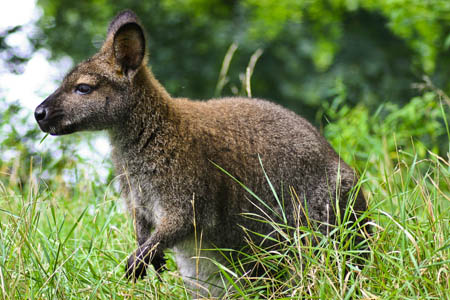Moorland walkers may get a surprise after separate sightings of a rare example of wildlife.
Wallabies have been spotted in both the South Pennines and the North York Moors. There are also reports of the Australian marsupials loose in the Peak District.
With the onset of darker days, the chances of spotting the macropods increases, as they favour foraging at dusk or at night. There have been sightings on the West Yorkshire moors near Stanbury and at Tollerton, near York. The Peak District wallabies inhabit an area near the popular climbing crags at the Roaches, in Staffordshire.
There is also a colony on Inchconnachan on Loch Lomond, members of which have been known to hop over to the shore when the loch freezes over.
Native to Australia, the small, kangaroo-like creatures are suited to the habitat in Britain, and are herbivores, feeding in moorland and wooded areas. There are more than 30 species of the marsupial, most in Britain being red-necked wallabies.
The animals grow to a height of about a metre and a typical lifespan for a feral wallaby is nine years. Most living wild in Britain are believed to have escaped from zoos, wildlife parks and private collections.
So if your headtorch catches an odd-looking beast in the heather, don’t rush to Specsavers – you’ve probably just spotted one of Britain’s small number of Aussie imports.
Wallabies have been spotted in both the South Pennines and the North York Moors. There are also reports of the Australian marsupials loose in the Peak District.
With the onset of darker days, the chances of spotting the macropods increases, as they favour foraging at dusk or at night. There have been sightings on the Yorkshire moors near Stanbury and at Tollerton, near York. The Peak District wallabies inhabit an area near the popular climbing crags at the Roaches, in Staffordshire.
There is also a colony on Inchconnachan on Loch Lomond, members of which have been known to hop over to the shore when the loch freezes over.
Native to Australia, the small, kangaroo-.like creatures are suited to the habitat in Britain, and are herbivores, feeding in moorland and wooded areas. There are more than 30 species of the marsupial, most in Britain being red-necked wallabies.
The animals grow to a height of about a metre and a typical lifespan for a feral wallaby is nine years. Most living wild in Britain are believed to have escaped from zoos, wildlife parks and private collections.
So if your headtorch catches an odd-looking beast in the heather, don’t rush to Specsavers – you’ve probably just spotted one of Britain’s small number of Aussie imports.

![[CC-2.0]](/lib/img/layout/cc-attr.gif)